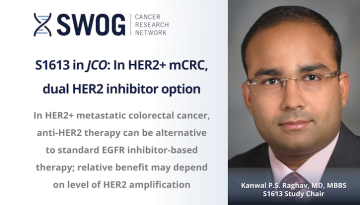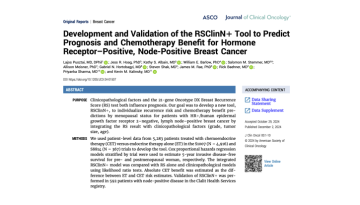S2302 Pragmatica-Lung: Have You Heard?
SWOG’s S2302 Pragmatica-Lung trial has gotten more pre-launch press than probably any other trial I can remember. And it’s with good reason – it stands to change the way network groups in the NCTN run many of our trials.
This story starts with the results of the S1800A Lung-MAP sub-study, which Karen Reckamp, MD, MS, delivered in an oral presentation at ASCO this past June. They showed that patients with advanced non-small cell lung cancer (NSCLC) that had progressed on previous immunotherapy had significantly longer overall survival (OS) with the combination of ramucirumab and pembrolizumab versus getting one of the current standard therapies.
The S1800A results, from a phase 2 study of 136 patients, needed validation in a larger phase 3 trial. In an August meeting with the Food and Drug Administration (FDA) aimed at discussing the possible design of such a study, Richard Pazdur, MD, director of the FDA’s Oncology Center of Excellence, conveyed his vision of a stripped-down registration study with laser-like focus on the most important question: does this drug combination help these patients live longer?
It was a vision that clicked with many on that call, and it would bring us to a dramatically streamlined pragmatic trial design. It came with a mission to get the protocol developed, approved, and launched in record time. Now, it’s late December and the pre-activation revision of that protocol was recently submitted to the NCI. We’re on target for a mid-January launch.
What is “dramatically streamlined”? For starters, the S2302 Pragmatica-Lung study has all of two objectives: 1) compare OS between arms and 2) summarize adverse events (AEs) that are Grade 5 or that are Grade 3 or 4 if they are serious or unexpected (we already have plenty of previous data on AEs for these agents).
A core element of this pragmatic approach is a stripped-down set of eligibility criteria: the trial will enroll adults, performance status 0 to 2, with stage 4 or recurrent NSCLC who have received prior chemotherapy and have acquired resistance to immunotherapy. The protocol fleshes out a few additional eligibility criteria, but that’s essentially it.
The bare bones eligibility requirements mean the trial can enroll a group of patients who represent a huge portion of the entire spectrum of patients with advanced NSCLC.
And to ensure we can enroll these patients quickly, we have tried to make it extraordinarily easy for all sites to open and conduct the trial.
Site staff won’t need to collect specimens, images, or patient-reported outcomes. The number of data elements they will have to collect, and the frequency of collection, have both been minimized.
The net outcome is a model for a much leaner study, one that can be easily run everywhere care is provided and that can provide trial access to an incredibly diverse group of patients. It can still serve as a registration trial.
Such a model could – and I predict will – transform the way we do trials within the NCTN.
You’ll hear more about S2302 Pragmatica-Lung soon. Please open it at your site when you do. It’s exciting, and it represents the future!
This is my last Front Line of 2022, so I want to take a moment to say thank you to all SWOG members and supporters for an outstanding year of improving lives through cancer research! Front Line will return in January with our 2022 Impact Report.
Other Recent Stories



